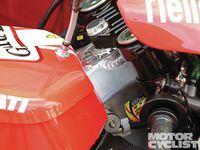The story of the superstar racer, brilliant engineer and genius technician locked in a battle to find enough speed to make the scrappy, innovative factory world champion once again would make a great movie. Of course, in the movie they would win, achieving the ultimate success. At Ducati they aren’t that far along yet.
The tale, of course, is that of Valentino Rossi, Filippo Preziosi and Jeremy Burgess as they wrestle with Ducati’s latest MotoGP racer. Rossi (and fellow factory rider Nicky Hayden) hasn’t been able to find confidence in the bike, mostly due to his inability to “read” what the front tire is doing. Lack of information from the chassis equals a lack of confidence, speed and results. The expectations of the Rossi/Ducati pairing were really high, and an average finish of sixth in the series’ 13 races to date doesn’t measure up. Even worse is the gap to first place: an average of 30 seconds at the finish.
The fact that people as experienced as Rossi, Preziosi and Burgess can be stymied by a motorcycle’s behavior is less a reflection on their abilities than a demonstration of how staggeringly complex such motorcycles can be. Any motorcycle is a system: a grouping of parts and assemblies that demonstrates certain behaviors when energized. Each major part, and all of the smaller ones in between, must be considered factors in the overall behavior of the bike as drive, brake, cornering and other forces are applied. Those forces create vibrations, movements and distortions that can resonate through the system in benign or destructive forms. Sometimes they combine to confuse the feedback riders need in order to know a bike’s limits.
As an example, I once investigated a touring motorcycle accident in which it appeared that the muffler bracket had come unbolted, leaving the exhaust end of the muffler to swing back-and-forth a matter of inches. An abrupt highway lane change apparently began the muffler swinging, which caused a fork movement to the point of loss of control.
In that case, a flex—essentially a flexible muffler—caused a resonance, or series of reflections, through the chassis, which found a mirrored movement in the fork. When securely bolted the muffler was no problem at all, and since there was a clear error in the assembly, it was pretty easy to trace the chain of events.
In the case of the MotoGP Ducati, it has been anything but easy to find what might be causing problems. Observers have suggested that the carbon-fiber steering-head structure might be too stiff—or not stiff enough. Others have pointed to the 90-degree V-angle of the engine, or criticize the swingarm’s attachment to the engine cases. Noting Burgess’ many years of success with Honda and Yamaha aluminum spar frames, some also suggest Ducati abandon carbon frames. Spy photos indicate that an aluminum frame may have been tested, but Ducati isn’t talking.
The behavior of a motorcycle is so complex, even experts can be confused and perplexed by its unpredictability. The solution may come in a flash of genius, with a bold redesign, or it may come in a series of small, seemingly unimportant changes that chip away slowly at the problem. Preziosi and Burgess may eventually understand what was wrong, or they may succeed without understanding exactly what worked and why. And, of course, they may fail.
The story so far of the superstar racer, the brilliant engineer and the genius technician is one of failure. And, for that reason, it’s the most interesting motorcycling story of the year for me. The principals are working long hours to learn the cause of their problems. Fabricators are making new parts to effect a cure. The many observers who comment are suggesting solutions. We’ll all learn a lot more from these failures and frustrations than from a smoothly ordered series of wins. Success isn’t necessarily boring, but failure surely is fascinating stuff.













/cloudfront-us-east-1.images.arcpublishing.com/octane/VZZXJQ6U3FESFPZCBVXKFSUG4A.jpg)
/cloudfront-us-east-1.images.arcpublishing.com/octane/QCZEPHQAMRHZPLHTDJBIJVWL3M.jpg)
/cloudfront-us-east-1.images.arcpublishing.com/octane/HXOUJXQWA5HBHGRO3EMJIGFMVI.jpg)

/cloudfront-us-east-1.images.arcpublishing.com/octane/3TIWWRV4JBBOLDVGRYECVVTA7Y.jpg)
/cloudfront-us-east-1.images.arcpublishing.com/octane/KIX5O23D5NAIBGFXBN3327DKZU.jpg)
/cloudfront-us-east-1.images.arcpublishing.com/octane/7GJYDUIPXRGMTMQKN6ONYOLBOU.jpg)
/cloudfront-us-east-1.images.arcpublishing.com/octane/MUQLOVLL2ZDGFH25ILABNBXKTI.jpg)
/cloudfront-us-east-1.images.arcpublishing.com/octane/TNOU5DNE2BC57MFPMGN2EIDXAM.jpg)
/cloudfront-us-east-1.images.arcpublishing.com/octane/GTCXACQGJ5HAPDTGWUQKDEH44E.jpg)
/cloudfront-us-east-1.images.arcpublishing.com/octane/S35YGSEMEZB4BLTDJTSZPF4GLA.jpg)
/cloudfront-us-east-1.images.arcpublishing.com/octane/5UOT6HPX2JFMRJAX6EH45AR4MQ.jpg)
/cloudfront-us-east-1.images.arcpublishing.com/octane/OKWOJWAKP5EP3OACCRRWPCIX2Q.jpg)
/cloudfront-us-east-1.images.arcpublishing.com/octane/2WF3SCE3NFBQXLDNJM7KMXA45E.jpg)
/cloudfront-us-east-1.images.arcpublishing.com/octane/G4MG6OUCJNBSHIS2MVVOTPX65E.jpg)
/cloudfront-us-east-1.images.arcpublishing.com/octane/IIGGWFOTOJGB7DB6DGBXCCMTDY.jpg)
/cloudfront-us-east-1.images.arcpublishing.com/octane/QSTCM6AVEZA5JJBUXNIQ3DSOF4.jpg)
/cloudfront-us-east-1.images.arcpublishing.com/octane/U4I7G625B5DMLF2DVIJDFZVV6M.jpg)
/cloudfront-us-east-1.images.arcpublishing.com/octane/B6XD6LS6IVCQPIU6HXDJSM3FHY.jpg)
/cloudfront-us-east-1.images.arcpublishing.com/octane/ICL63FEDDRDTTMINYICCEYGMDA.jpg)
/cloudfront-us-east-1.images.arcpublishing.com/octane/FCGZHQXRBZFLBAPC5SDIQLVF4I.jpg)
/cloudfront-us-east-1.images.arcpublishing.com/octane/WNOB6LDOIFFHJKPSVIWDYUGOPM.jpg)

/cloudfront-us-east-1.images.arcpublishing.com/octane/X33NU3E525ECRHXLNUJN2FTRKI.jpg)